|
Stereophonic Sound Effects in Walt Disneybs Film Fantasia.
Stereophonic reproduction, which has been demonstrated to limited audiences on many occasions, takes a step nearer to commercial realisation in the original prints of the film Fantasia which, together with special auxiliary equipment, are touring the principal cinemas of the United States.
When the history of the development of high-quality sound reproduction comes to be written, a prominent landmark will undoubtedly be the sound tracks of Walt Disney's recent film Fantasia.
In this film sound is not so much the accompaniment as the starting point of the ideas expressed in the animated colour cartoons shown on the screen. It is divided into eight sections, each taking for its theme a well-known musical classic played by a first-class orchestra, the Philadelphia Philharmonic, under the baton of Leopold Stokowski. It is not within the scope of this journal to describe the pictorial side, which will no doubt be enjoyed by those of our readers who see it, but we can give some details of the sound-recording technique developed by RCA for the full-scale stereophonic reproduction of the music at the first showing of the film in the principal theatres of America.
Special equipment was sent from place to place with the film and auxiliary loud speakers were installed to handle the large sound output and to ensure correct balance for the stereophonic effects. Unfortunately, the war has prevented the showing of the original prints in this country, but the specially combined single sound track which has been prepared for use with existing projectors bears unmistakeable traces of the unusual character of the original edition and of the subsequent adjustment of balance and heightening of contrasts in the orchestral playing by the conductor.
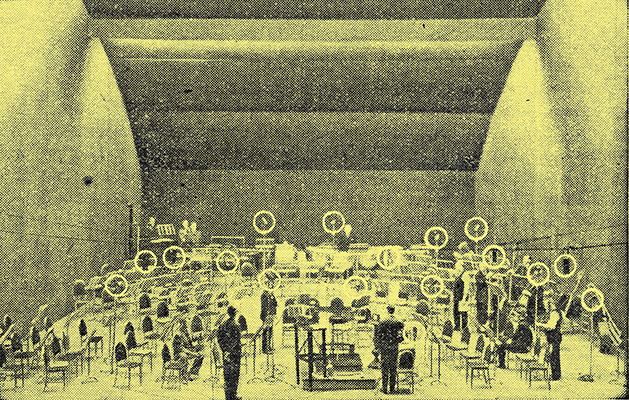
Grouping the players for stereophonic recording of the orchestra. Tentative microphone positions are indicated by the white circles.
The raw materials, so to speak, from which the final sound tracks were composed, were drawn from microphones distributed at strategic points throughout the body of the orchestra. One of the accompanying photographs shows that at least seventeen pick-up points were used in the preliminary balance and control tests. Finally, eight simultaneous recordings were made with microphones at six points in the orchestra and two others as follows?
- Violins,
- Cellos,
- Violas,
- Brass,
- Wood Wind,
- Percussion,
- Mixed output from whole orchestra,
- Microphone pick-up at a distance from orchestra.
The last two sound tracks provided what might be termed first proofs of the recording. These were examined critically by the conductor and if the efforts of his players fell short of his ideals of what the music required, adjustments were effected when the final sound tracks were made up from the six primary channels arriving from different points of the orchestra. These were combined into three tracks associated with the centre, left and right-hand groups of players, and when re-produced through loud speakers similarly placed in the space behind the screen, gave the effect of auditory perspective obtained from listening to a real orchestra. With the help of extension speakers arranged round the auditorium, the audience were at times made to feel that they were in the midst of the players themselves. Obviously some of the illusion would be lost if the volume range of the orchestra, normally about 70 dB, were restricted to the accepted limit of 35 dB for variable area recording. Accordingly, a system of automatic volume expansion was introduced and a fourth sound track was employed to control each of the three main sound tracks. The latter were of double width, thus adding 6 dB to the maximum level which could be recorded, and increasing the available range to 41 dB. Nevertheless, to be quite sure that film noise due to grain and scratches should be at all times completely suppressed it was decided to limit the recording range to 25 dB and each sound channel was passed through a volume compression circuit which kept down maxima and brought up minima within these limits. The automatic fluctuations of bias in the compression circuits were made to modulated fixed frequencies which were recorded simultaneously as a complex tone on the fourth track. In playing back the record, filters separated the three control frequencies (250, 630 and 1,600 Hz) and after rectification the variations of amplitude were applied as control bias to the variable gain amplifiers at the head of each amplifying channel.
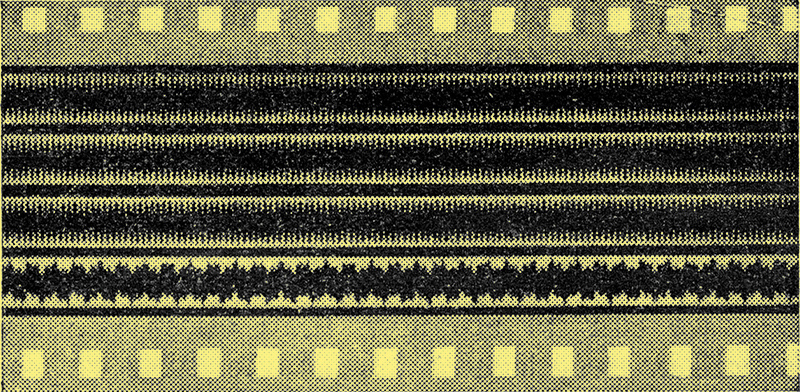
Test specimen of special sound track. The complex wave form contains the three control frequencies for volume expansion.
The four sound tracks occupy the full width of a standard 35 mm film, which is printed quite separately from the picture. The sound film is run through a separate machine, which is synchronised with the picture projector by means of a master three-phase generator, and separate 'Selsyn' [★] The Selsyn motors are self synchronizing AC motor/generator sets that became known as synchro's. Selsyn is a trade name. The purpose is to keep all the projectors phase locked.motors. In the special sound head which has been developed for this purpose, a single reversible exciter lamp is provided which enables the spare filament to be brought into action merely by reversing the lamp in its socket. The light is formed into a beam one mm wide and of a length sufficient to scan all four tracks. As the light covers the whole width of the film, the standard rotary stabiliser and solid take-off drum could not be employed, and a special scanning aperture in conjunction with a magnetically driven drum was used. The scanning light modulated after passing through the film passes to the four separate photocells housed together with their matching transformers in a compartment on what would be the front of the machine if it were a picture projector.
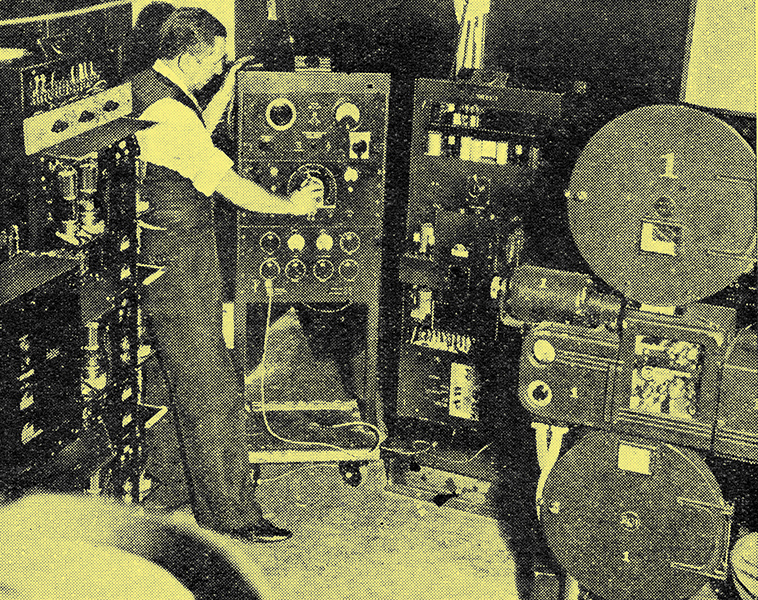
A corner of the projection room. One of the new multi-track sound heads is to be seen on the extreme right of the picture.
After passing through the usual operator's fader control relays, the output from the three main sound tracks goes via pre-amplifiers to the main amplifier channels. The complex control tone is amplified separately, and applied to each of the variable gain amplifiers associated with the main channels where the appropriate tone is selected by a band pass filter, rectified, smoothed and applied as bias to the amplifier. The control stage consists of two 6K7 valves in push-pull [★] As a vari-μ pentode for IF amplification the 6K7 will operate on the non-linear part of the characteristic curve without causing distortion as the anode circuit will be tuned and resonant. However, for audio amplification using the non-linear part of the curve, distortion is inevitable. RCA engineers determined that most of the distortion was second order and that thus a matched pair in push-pull could cancel out the main distortion. Therefore the TOGAD amplifier has transformer input and output. The input transformer achieves the phase splitting and the output transformer provides the cancelling of the second harmonic. The following stages are conventional single ended signal amplifiers., and manual control of the expansion characteristic is available in order that the overall volume range may be adjusted to suit the size and acoustics of individual theatres.
700 Watts in Reserve
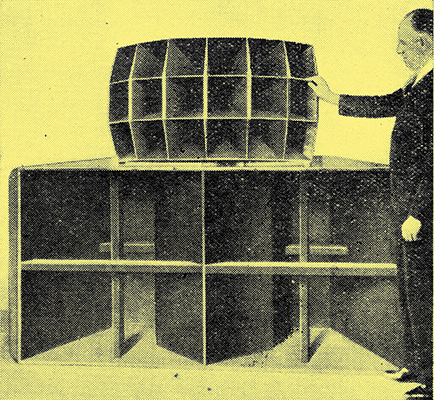
Two of these wide-range RCA loudspeaker systems were used in each of the three stereophonic channels on the stage, the outside channels being supplemented by 22 small extension units down each side of the auditorium.
The power output available from each of the main channels is 120 Watts, and this is absorbed by two of the standard RCA multiple loudspeaker units. These units each consist of two HF tweeters feeding into cellular horns and four large diaphragm speakers loaded by re-entrant horns. Separate 50 Watt amplifiers taking their input through attenuator pads from each side channel feed 22 small cabinet speakers arranged along each side of the theatre. Actually, the amplifiers rated at 120 Watts are each capable of delivering 200 Watts with only 2% distortion, so that in practice a total of 700 Watts distributed through 80 loudspeaker elements was available at the first showing of the film in New York. This power is, of course, in reserve for climaxes in the music and will not always be used in the smaller theatres to which the full stereophonic equipment is taken.
In addition to the specially combined single sound track which has been printed for standard equipment, and which is the one at present shown in this country, there is another simplified version of 'Fantasound' which retains the volume expansion feature, but not the stereophonic effects. This is known as 'Vita-sound' and is being used in the Warner Brothers theatres in the United States, In this the control track is printed in the spaces between the sprocket holes at the edge of the film, and is used to vary the strength of the 96 Hz current produced by the sprocket holes themselves. A variable gain amplifier is introduced in the chain leading to the screen loud speakers and additional house speakers are brought in to handle climaxes, the amplifier feeding them being normally biased to cut-off. This system seems very promising for screen plays where dialogue can be confined to the central loudspeakers, the side speakers being brought in only for music or special effects.
One way or another the film Fantasia has created a stir of the first magnitude, and while critics may wrangle over this or that aspect of the association between art and music, the significant thing from the technical point of view is that stereophonic sound is being given its first commercial trial. [★] The Fantasound could cost $85,000.00 to install in a theatre and the main racks occupied some 23 foot of wall space and used some 400 valves. This was an uneconomic prospect for most theatres and it was used in the original form in only 14 presentations. Leopold Stokowski, who has been a consistent supporter of all previous tests of stereophonic reproduction in America, and the RCA Photophone engineers who have been responsible for the design of the apparatus, are to be congratulated on their enterprise.
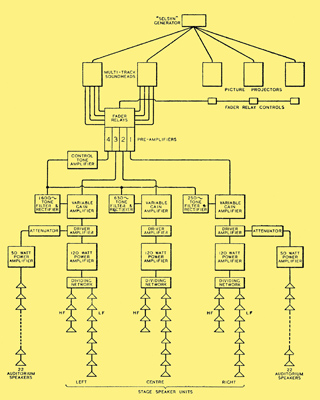
Schematic diagram of amplifier equipment used for the stereophonic sound effects in Fantasia.
|